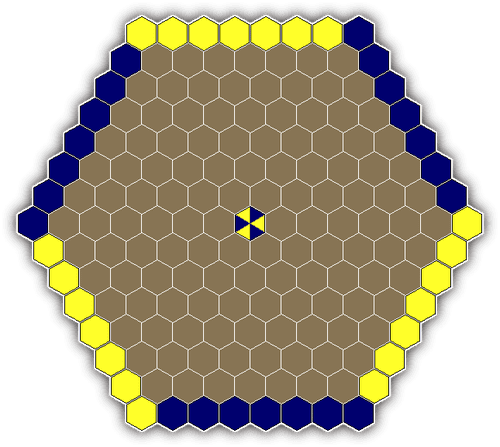|
Advertisement
|
Migong

DescriptionMigong is a two-player territory game played on the 126 brown spaces (cells) of the initially empty hexagonal board shown above. The two players are called Blue and Yellow. Each player has access to 63 cell-sized hexagonal pieces made of six equilateral triangles each. Each player's set of pieces includes all combinations of at least one triangle of their color and at most five triangles of the opponent's color. Pieces have a fixed orientation and are never rotated or flipped during play. Any pattern of triangles that would result from rotating or flipping a piece is represented by another piece. DefinitionsA wedge is one of the six triangular portions of a piece. A group is a wedge along with all other wedges one could reach from it through a series of steps between like-colored wedges sharing an edge with one another. Thus, all wedges in a group are the same color, and a group may include wedges from different pieces. A group's extent is the number of pieces that contribute wedges to it. PlayBlue plays first, then turns alternate. On your turn, if possible, place a piece from your set on an empty cell. Wedges from different pieces sharing an edge must be the same color. Likewise, a wedge must be the same color as any board edge sharing an edge with it, including the cell-like border in the center. If you have no moves available, you must pass. Passing is otherwise not allowed. The game ends when both players pass in succession. The player with the higher score in the final position wins. Your score is the biggest group extent in which you have the greater number of groups. If there is no such size, your score is zero. If both players are tied at zero points, whoever made the last move loses. Pie ruleThe pie rule is used in order to make the game fair. This means Yellow will have the option, on their first turn only, to swap sides with their opponent instead of making a regular move. Game DiscussionsAdd CommentYou need to be logged in to comment. Insert Bullet List Please enter at least one item. Item: Item: Item: Item: Item: Insert Numeric List Please enter at least one item. Item: Item: Item: Item: Item: Insert Link Please enter the link of the website Optionally you can add display text Insert Email Please enter the email address Optionally add any display text Insert Image Please enter the link of the image Insert YouTube Video Please enter the link of the video Marketplace | ||||

Comments (0)